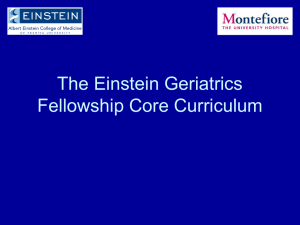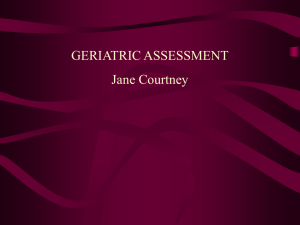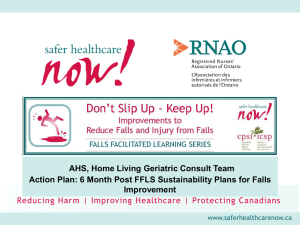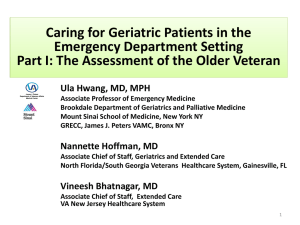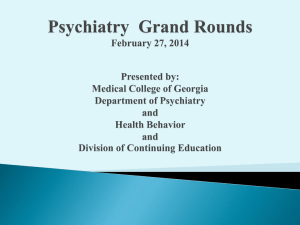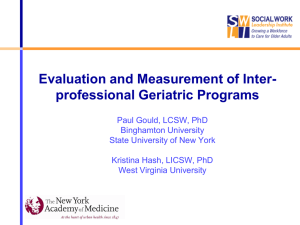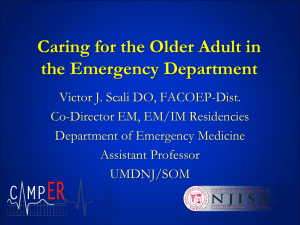Roles of Palliative Care Team at EOL
advertisement
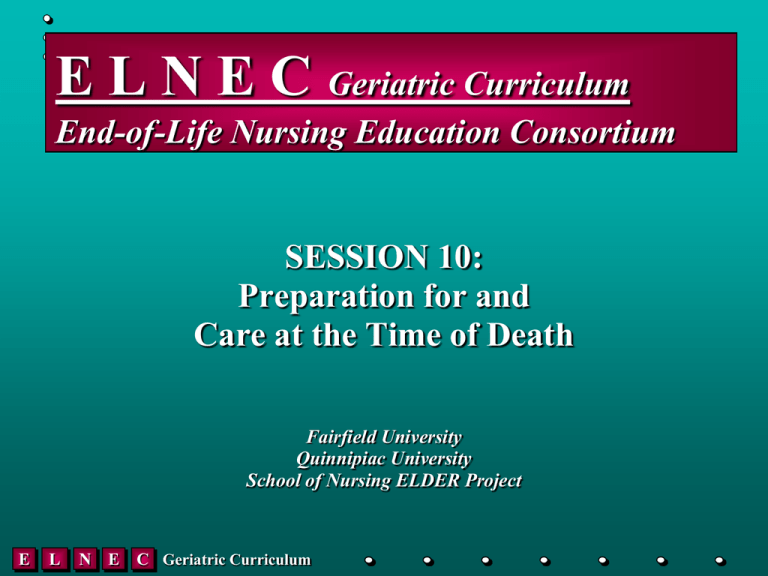
E L N E C Geriatric Curriculum End-of-Life Nursing Education Consortium SESSION 10: Preparation for and Care at the Time of Death Fairfield University Quinnipiac University School of Nursing ELDER Project E L N E C Geriatric Curriculum Objectives: Upon completion of this session, the participant will be able to … 1. 2. 3. E L Describe typical changes and events at the time of dying. Examine the role of the palliative care team at the time of death. Identify self-care strategies for the health care team that promote well-being and health. N E C Geriatric Curriculum Dying is an Individualized Personal Experience E L N E C Geriatric Curriculum Palliative Care Team Roles at EOL • Support older adults/residents, families, and staff prior to and following the death • Coordinate care • Advocate for patients and families • Being present, bearing witness • Provide pain and symptom management • Role model self-care behaviors E L N E C Geriatric Curriculum ACTIVITY: Roles of Palliative Care Team at EOL E Advocate Pain & Symptom Management Being Present Modeling SelfCare Behaviors L N E C Geriatric Curriculum An 85-year-old client with end-stage heart disease arrives unconscious at the emergency department after sustaining her third myocardial infarction. The doctor has told the daughter that without CPR her mother could die today. The healthcare •worker finds the daughter crying by the client's bedside. What should the healthcare worker do? 1. ask the daughter if she would like to reconsider treatment 2. talk to the doctor about moving the client to a more private place 3. stay with the daughter, using silence to give comfort 4. assure the daughter that she doesn't need to stay with her mother E L N E C Geriatric Curriculum Offering Support During the Death Vigil • Common fears – Being alone with resident – Not knowing when death occurs – Painful death E L N E C Geriatric Curriculum Nearing-Death Phenomena • • • • • E L N E C Geriatric Curriculum “The Rally” Symbolic language Visions Inability to let go Saying good-bye Two Roads to Death Confused Restless THE DIFFICULT ROAD Tremulous Hallucinations Mumbling Delirium NORMAL Myoclonic Jerks Sleepy Lethargic Seizures Obtunded THE USUAL ROAD Semicomatose Comatose DEAD E L N E C Geriatric Curriculum Ferris et al., 2003 Frequency of Symptoms Last 48 Hours Fürst & Doyle, 2004; Lunney et al., 2002 E L N E C Geriatric Curriculum Pain when Death is Imminent • Common among NH residents at EOL • Assume pain is present after ruling out other possible causes of distress! E L N E C Geriatric Curriculum Opioids at EOL • Consider routes – Oral – Rectal – Subcutaneous • There is no evidence that opioids hasten death! E L N E C Geriatric Curriculum Noisy Respirations • Noise produced by turbulent movements of secretions in upper airways; this symptom occurs in the imminently dying • Also called “death rattle” • Occurs in 23–92% of dying patients E L N E C Geriatric Curriculum Anticholinergics • Hyoscine hydrobromide (Scopolamine) • Glycopyrrolate (Robinul) • Hyoscyamine (Levsin) • Atropine Sulfate E L N E C Geriatric Curriculum Nondrug Strategies • Reposition patient or resident on his side • Gently suction mouth if the secretions are easily reached • Provide excellent oral care • Educate and reassure family E L N E C Geriatric Curriculum Terminal Restlessness • Occurs in the last days or hours of life • May be exhibited by thrashing, muscle twitching or jerks, fidgeting, frequent attempts to get out of bed, calling out, moaning, non-purposeful movement • Focus on providing comfort rather than treating the cause Ingham & Caraceni, 2002 E L N E C Geriatric Curriculum Symptoms of Imminent Death • • • • • • • Decreased urine output Cold and mottled extremities Vital sign and breathing changes Respiratory congestion “Death rattle” Delirium/confusion Restlessness Kehl, 2004; Matzo, 2009; Rousseau, 2002 E L N E C Geriatric Curriculum Signs That Death Has Occurred • • • • • E Absence of heartbeat, respirations Pupils fixed Pale color Body temperature drops Muscles, sphincters relax L N E C Geriatric Curriculum Grief is: • 1. 2. 3. 4. E L the emotional response to a loss the outward, social expression of a loss the depression felt after a loss the loss of a valued object or loved one N E C Geriatric Curriculum The best response to a client who is anticipating a loss is to: • 1. educate them about disease progression 2. stress that prognosis is difficult to predict 3. provide therapeutic presence and practice active listening 4. advise the daughter to focus more on the present than the future E L N E C Geriatric Curriculum In speaking with clients and families about grief, the healthcare worker explains that grief: 1. is a process with predictable stages of work to be done 2. begins when people expect a loss or death 3. lasts a year or less, and then survivors should adapt to the loss 4. includes personal feelings that are understood by everyone E L N E C Geriatric Curriculum Care Following Death • Bathing and dressing the body • Positioning the body • Respect cultural practices • Allow for closure E L N E C Geriatric Curriculum In caring for the body after death, it is most important to: • 1. make sure the body is sent to the morgue within an hour after death 2. have family members participate in the bathing and dressing the deceased 3. notify all family and team members regarding the patient's death 4. provide a clean, peaceful impression of the deceased for the family E L N E C Geriatric Curriculum The wife of a client who recently died states: "Last night I thought I heard him say ‘Good night, Honey’ just like he always did. Do you think I am going crazy?" The most helpful response is: 1. "You might want some extra support accepting your husband's death. I'll have the doctor make a referral to a psychologist." 2. "Many people see or hear the one who has died. You must miss him saying 'good night'." 3. "Many people believe that ghosts or spirits visit their loved ones. Do you believe in ghosts or spirits?" 4. "That must be frightening for you. Do you have a friend or relative who can stay with you so that you are not alone?" E L N E C Geriatric Curriculum Care Following Death (cont.) • Rigor mortis 2-4 hrs after death • Embalming • Removal of body E L N E C Geriatric Curriculum The hospice team is caring for the family of a man who died several days ago after a long illness. His wife is concerned that their 9 year old son has become withdrawn and is easily angered. Which action is most appropriate? 1. Refer the boy to a specialist for complicated (abnormal) grief reaction. 2. Suggest that the boy be excused from his usual activities. 3. Give opportunities for the boy to express his feelings. 4. Tell stories rather than facts about death to the boy. E L N E C Geriatric Curriculum Acknowledging Death E • • • • • Inform staff Inform roommate Memory book Recognition wall Paying tribute L N E C Geriatric Curriculum Lifestyle Management: Burnout Prevention for Staff • Healthy body • Healthy mind • Healthy spirit • Healthy social life E L N E C Geriatric Curriculum The healthcare team may experience feelings of anxiety and grief when caring for dying clients. To deal with these feelings it is important to: • 1. 2. 3. 4. E L get the assistance of team members when necessary transfer to another unit to avoid caring for dying patients keep an emotional distance from clients and families schedule counseling at weekly intervals to deal with loss issues N E C Geriatric Curriculum Activity: Self-Care Assessment Take a moment to consider the frequency with which you do the following acts of self-care. Rate using the scale below: 4 = often 3 = sometimes 2 = rarely 1 = are you kidding? It never even crosses my mind! E L N E C Geriatric Curriculum Conclusion Family members will always remember the last days, hours, and minutes of their loved one’s life. Nurses have a unique opportunity to be invited to spend these precious moments with them and to make those moments memorable in a positive way. E L N E C Geriatric Curriculum References City of Hope & the American Association of Colleges of Nursing, 2007; Revised, 2010. The End-of-Life Nursing Education Consortium (ELNEC)- Geriatric Training Program and Curriculum is a project of the City of Hope (Betty R. Ferrell, PhD, FAAN, Principal Investigator) in collaboration with the American Association of Colleges of Nursing (Pam Malloy, RN, MN, OCN, Co-Investigator). Supported by DHHS/HRSA/BHPR/Division of Nursing Grant # D62HP06858 E L N E C Geriatric Curriculum

